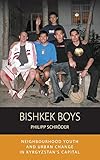Bishkek Boys : Neighbourhood Youth and Urban Change in Kyrgyzstan’s Capital / Philipp Schröder.
Material type: TextSeries: Integration and Conflict Studies ; 17Publisher: New York ; Oxford : Berghahn Books, [2017]Copyright date: ©2017Description: 1 online resource (258 p.)Content type:
TextSeries: Integration and Conflict Studies ; 17Publisher: New York ; Oxford : Berghahn Books, [2017]Copyright date: ©2017Description: 1 online resource (258 p.)Content type: - 9781785337260
- 9781785337277
- 305.235095843 23
- HQ799.K982 B577 2017
- online - DeGruyter
| Item type | Current library | Call number | URL | Status | Notes | Barcode | |
|---|---|---|---|---|---|---|---|
 eBook
eBook
|
Biblioteca "Angelicum" Pont. Univ. S.Tommaso d'Aquino Nuvola online | online - DeGruyter (Browse shelf(Opens below)) | Online access | Not for loan (Accesso limitato) | Accesso per gli utenti autorizzati / Access for authorized users | (dgr)9781785337277 |
Browsing Biblioteca "Angelicum" Pont. Univ. S.Tommaso d'Aquino shelves, Shelving location: Nuvola online Close shelf browser (Hides shelf browser)

|

|

|

|

|

|

|
||
| online - DeGruyter Affective States : Entanglements, Suspensions, Suspicions / | online - DeGruyter Indigeneity on the Move : Varying Manifestations of a Contested Concept / | online - DeGruyter Cyprus and its Conflicts : Representations, Materialities, and Cultures / | online - DeGruyter Bishkek Boys : Neighbourhood Youth and Urban Change in Kyrgyzstan’s Capital / | online - DeGruyter The Ethics of Seeing : Photography and Twentieth-Century German History / | online - DeGruyter Staging Citizenship : Roma, Performance and Belonging in EU Romania / | online - DeGruyter Dreams Made Small : The Education of Papuan Highlanders in Indonesia / |
Frontmatter -- Contents -- List of Illustrations -- Acknowledgements -- Notes on Transliteration and Naming -- Introduction The Playground Incident, the Field and a Conceptual Framework -- Chapter 1. Authority and Resource: Batyr as a Leader in Shanghai -- Chapter 2. Territory: Kanat and the Other Yards -- Chapter 3. Disconnection: Bolot and the Generation ‘off the Streets’ -- Chapter 4. Respect and Responsibility: Semetei and the Other Bratishki -- Chapter 5. Solidarity: Metis, Ulan and Friendship Relations -- Chapter 6. Acquaintances: Maks and Interethnic Relations -- Chapter 7. Urban Socialization: Tilek and the Newcomers -- Conclusion From Shanghai to Iug-2 and Bishkek’s Postsocialist Trajectory -- List of Main Characters -- Glossary of Selected Terms -- References -- Index -- Integration and Conflict Studies Published in Association with the Max Planck Institute for Social Anthropology, Halle/Saale
restricted access online access with authorization star
http://purl.org/coar/access_right/c_16ec
In this pioneering ethnographic study of identity and integration, author Philipp Schröder explores urban change in Kyrgyzstan’s capital Bishkek from the vantage point of the male youth living in one neighbourhood. Touching on topics including authority, violence, social and imaginary geographies, interethnic relations, friendship, and competing notions of belonging to the city, Bishkek Boys offers unique insights into how post-Socialist economic liberalization, rural-urban migration and ethnic nationalism have reshaped social relations among young males who come of age in this Central Asian urban environment.
Mode of access: Internet via World Wide Web.
In English.
Description based on online resource; title from PDF title page (publisher's Web site, viewed 25. Jun 2024)


